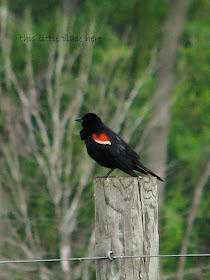Nope, this post, this Diversity, is about my observations on how the flora and fauna of this little place here has changed in the twelve years we've owned it. How it was as a farm field (conventionally grown grain crops) with a chunk of woods, a weedy wooded fence line, and a road frontage with a few large walnut trees but mostly brush and vines. How it is now with hay field, yard, garden, orchard, partially cleaned road frontage and fence line, and it's original wooded chunk.
The first thing I noticed, when we began making our personal mark on the land, was the absence of earthworms. No matter where in the vast acreage of field I dug, I could hardly find an earthworm. That just seemed so strange to me. Worms live in the soil, so why, with all these acres of soil, could I not find even a handful of worms? What was up with that?
The second thing I noticed, when we attempted to grow a small patch of pumpkins and corn in what was cut off from the acres of field by the loop in our driveway (a piece of ground we commonly refer to as "The Circle"), was that the soil was hard, pale clay. And that no matter how much water we hauled to those plants, they didn't grow. Every single seed had sprouted willingly, but after that initial sprout, it was all downhill for those poor plants. Despite the watering and the weeding, they were all pale, sickly looking seedlings. Most of them died within a few weeks, and all of them by about the ten week mark. Not a single pumpkin nor ear of corn was produced. Meanwhile, back at our other home, the one we owned and lived in prior to buying this little place here and completing construction on this house, my garden thrived. Same weather, same care in terms of watering and weeding, even same variety of seeds, but different soil. At that house the garden had been carved out of a long-time lawn, the soil was sandy loam, and it received an application of composted pony manure every fall/winter. No sprays or pelleted fertilizer had ever touched that garden (due to DS2's sensitivity to chemicals), unlike the nasty clay soil I was trying to grow corn and pumpkins on at this little place here. Interestingly, the corn in the garden at the other house was a healthy dark green and thrived all summer long, growing taller than DH and producing well shaped ears that were filled with juicy kernels.
As the years went by, and I started an official garden plot at this little place here, I hauled in, spread on, and tilled in several tons of composted horse manure. As the years went by, the soil in my garden loosened, and darkened, and didn't crust as badly. And the worms, oh my gosh, the worms! I can't put my trowel in the soil anywhere in that garden and not come up with two or three or more earthworms. What a difference from not one worm in a whole shovelful of soil at the beginning of my gardening endeavors at this little place here. (Interesting sidenote: on the acres we lease out that are still farmed conventionally, there continues to be a lack of earthworms.)
It is not just the worms that have migrated in and thrived. The number of species of birds continues to increase. At first, we only saw birds in the woods, with the occasional starling taking up residence closer to the house (like in the boom of the backhoe we owned at the time). I was still putting out bird feeders back then, and rarely saw anything other than starlings and a few sparrows, with goldfinches showing up if I filled a feeder with thistle seed (something I really regret doing now, as thistles continue to be a nemesis in the garden, whereas before feeding the darn birds thistle seed there were no thistles. . .).
Now we have robins and larks and house finches, barn swallows and tree swallows, several types of sparrows, red winged blackbirds, hummingbirds, bobolinks, yellow warblers, kildeer, bluebirds, catbirds, and new this year is a northern mockingbird. And I have not set out a bird feeder in probably seven or eight years. They all have natural food sources here now, as well as nesting sites. When the majority of this little place here was mono-cropped, sprayed field, they didn't have that except on the edges: the woods, the overgrown road frontage and fence line. Now there are flowers and bushes and trees scattered here and there; there are the pests that like garden plants and herbs and hops--the pests that are the natural food source of those birds. As long as the birds are around, the pest population never gets so bad that it makes a negative impact on my harvest of those plants, herbs, and hops. I get fed, the birds get fed, and I get to enjoy the birds too.
I'm a believer in diversity. I've seen for myself what a difference there can be when there is a variety of plant life on a piece of land; how that in itself will bring in a diversified fauna, and how they all interact together to keep things balanced.
(As an example of how abundant the bird population has become, the following pictures were all taken so far this month, either in the garden, near the house, or near the barn.)
barn swallow in the rain
(they have a nest above one of the second story windows)
male gold finch
male red wing blackbird
bluebird
northern mockingbird





No comments:
Post a Comment